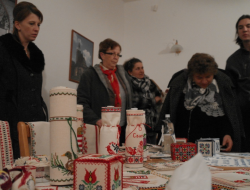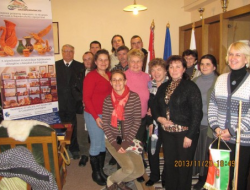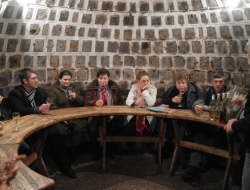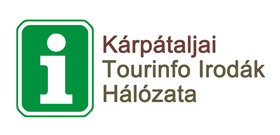A kárpátaljai népművészek magyarországi kollégáikhoz látogattak
2013-12-04 12:12:53
November végén kárpátaljai kézművesek ellátogattak Magyarország hozzánk legközelebb fekvő megyéjébe azzal a céllal, hogy megismerjék helyi kollégáik munkáit, átvegyék tapasztalataikat és megosszák velük sajátjaikat. A résztvevők között voltak olyan mesterek, akik közvetlenül őrzik, fejlesztik és adják tovább az utókor számára a népi mesterségek különleges titkait: kádárok, keramikusok, hímzők, szövők, ábrázoló művészek, ajándéktárgy készítők.
A rendezvény „A népművészet és a kézműipar fejlődésének elősegítése a Kárpátok Eurorégióban HUSKROUA/1101/163” elnevezésű projekt keretében valósult meg, melynek célja az ősi mesterségek és tradíciók fenntartása és fejlesztése a határmenti régióban.
Az utazás résztvevőit gazdag, háromnapos program várta, melynek első állomása Beregdaróc volt, ahol olyan kézművesek várták a résztvevőket, akik kenderből készítenek ajándék és használati tárgyakat. Sajnos, ez a valamikor hagyományosnak mondott, szövéshez használt alapanyag manapság Ukrajnában nem népszerű. Ezzel ellentétben Magyarországon termesztenek ipari kendert, feldolgozzák és csodálatos műalkotásokat készítenek belőle – törülközőket, abroszokat sőt még ajándéktárgyakat is. A határmenti magyar faluban múzeumot hoztak létre, ahol meg lehet tekinteni régi, fából készült szövőszékeket, melyek többsége ma is működőképes, valamint az azokon előállított termékeket is. A helyi mester, Sukta Bertalanné rögtönzött termékbemutatót is szervezett, melynek keretében a vállalkozó kedvűek kipróbálhatták a szövést avagy készíthettek ajándéktárgyakat – kenderből szőtt anyagból vászonvirágokat.
Tarpa községben Nagy Zsigmond farmer és vállalkozó mutatta be a helyi termékek (aszalt gyümölcsök, pálinka, cserépedények) boltját, valamint a hatalmas gyümölcsaszaló működését, ahol körtét, almát és szilvát aszalnak. Szívélyesen fogadta a kárpátaljai vendégeket a település polgármestere is, aki a helyi kézművességet bemutatva érdekes kirándulást is vezetett a településen. Többek között megtekinthettek egy működő és abszolút legális pálinkafőzdét is – ahol gyümölcspálinkákat készítenek, mely hagyományos magyar terméknek számít és hungarikum is egyben, ami nem más, mint az ország turisztikai jelképe.
A kárpátaljai delegáció Penyigén a Lekváriumot – a szilvalekvár múzeumot tekinthette meg. Innen származik az a szilva, melyből dzsemet, lekvárt, kompótot és alkoholos italokat is készítenek. Ezt a szilvafajtát jelentős területen termesztik – többek között Magyarországon, Romániában és Kárpátalján is. A szilvafajta Magyarországon elterjed neve - a „Nem tudom” szilva. A legenda szerint, amikor a településre felvásárlók érkeztek és a szilva fajtáját tudakolták, ezt a választ kapták a helyi lakosoktól. A helyi kézművesség és turizmus fejlődéséről a település polgármestere Juhász Gyula és a múzeum igazgatója Kőrösi Katalin tartottak előadást. Fontos megjegyezni, hogy Penyige az a település, ahol immár 3 éve hagyományosan megrendezésre kerül a helyi termékek népművészeti fesztiválja, melyen Szabolcs-Szatmár-Bereg megye valamennyi kézművese részt vesz. A fesztivál megrendezésének ötlete dr. Hanusz Árpádtól, a Falusi Turizmus Szabolcs-Szatmár-Bereg Megyei Szervezetének elnökétől ered, aki a jelen projekt megvalósításában is partnerként működik közre. A soron következő, hagyományosan augusztusban megrendezésre kerülő fesztiválra meghívást kaptak a kárpátaljai kézművesek is.
Különösen érdekesnek találtuk, hogy több településen is, főként falvakban, úgy nevezett „hagyományok háza” üzemel. Itt készítik el a településre jellemző egyedi termékeket – hímzéseket, szőtteseket, játékokat, emléktárgyakat stb. Hasonló működik Penyigén is. Gyakran munkanélküliek végeznek itt különböző hagyományőrző tevékenységet és munkájukért fizetést is kapnak. Ilyen módszerrel sikerül megőrizni a településeken a népi hagyományokat a Magyar Állam pénzügyi támogatásával. A helyi népművészekkel való találkozásra Tivadar településen került sor, ahol olyan hímzések díszítették a termet, melynek motívumai nagyon hasonlítanak a Kárpátalján is használt és népszerű motívumokhoz. Ez nem meglepő, hiszen a régió, bár ma államhatárral elválasztott két terület, történelmileg mégis azonos.
A soron következő szakmai találkozó Apagy településen került lebonyolításra. Itt termékbemutatót is szerveztek a magyarországi kollégák kosárfonásból valamint újévi és karácsonyi emléktárgyak készítéséből. Itt már a kárpátaljai mesterek is bemutathatták tudományukat – többek között Dvorák Oleksandr tehetséges és fiatal ilosvai keramikus is. A magyarországi népművészek munkájának sajátosságait olyan helyi mesterek mutatták be, akik vesszőből, szalmából és bőrből készítenek különböző népművészeti tárgyakat.
Az utazás immár a tokaji régióban folytatódott, ahol Szerencs településen ismerkedhettek a résztvevők a borkészítési tradíciókkal. Rozsnyai Géza borászmester borkóstoló keretében mutatta be a borkészítés érdekességeit. Az utazás utolsó állomása – a sóstói Múzeumfalu megtekintése volt, Nyíregyházán. Itt, a múzeum területén, a szabad ég alatt találhatóak azok a kézműves műhelyek, melyek a XIX. század végén és a XX. század elején működtek Magyarországon. Megtalálhatóak közöttük a különböző mesterségek színhelyei – bodnárok, szűcsök, pékek, fényképészek és fodrászok műhelyei is. Érdekesség, hogy ezek a műhelyek mind működőképesek – például akik ellátogatnak a skanzenbe kipróbálhatják a tradicionális mézeskalács készítést és az elkészült süteményeket a helyi kemencében ki is süthetik. Különösen népszerű tevékenység ez a gyerekek számára. A felnőttek addig megismerkedhetnek a hordókészítés valamint az anyagfestés hagyományos módszereivel.
Hamar eltelt így a három nap. Kézműveseink sok érdekeset láttak és kaptak, feltöltődhettek pozitív élményekkel. Hamarosan hozzájuk fognak ellátogatni újonnan megismert magyarországi kollégáik. Tarpai József, az Ukrán-Magyar Területfejlesztési Iroda igazgatója elmondta, hogy a projekt keretében szakmai kiadványt is készítenek Magyarország és Kárpátalja kézműveseiről. Augusztusban pedig a határmeti régió népművészei közösen vesznek majd részt a Penyigei kézműves fesztiválon, ahol a projekt eredményeit is összegzik majd.
Dr. Hanusz Árpád, magyarországi turisztikai szakember úgy fogalmazott, hogy minden ember életében a legfontosabb dolog, hogy a megszerzett tapasztalatait átadja az utókor számára. Ez, valamint a kézműves hagyományok megőrzése a jelen nemzetközi projekt mottója.
Vorosilov Oleksandr
- Kerékpáros zarándoklat Máriapócsra (videó)
- Visszakapja egykori patináját a beregszászi római katolikus plébániatemplom
- A templomok – a régió vallási és történelmi életének emlékei
- Lezárult a Visegrádi Civil Híd Ukrajnának képzési program
- Önkéntesek felkutatása, menedzselése és motiválása
- Szakmai találkozó Varsóban
- Kerékpáros zarándoklat Máriapócsra
- A civil szervezetek és az önkormányzatok közötti együttműködés – workshop a Visegradi Civil Híd Ukrajnának projekt keretében
- Szakmai találkozó Veszprémben
- Kerékpártúra Dobó István sírjához





